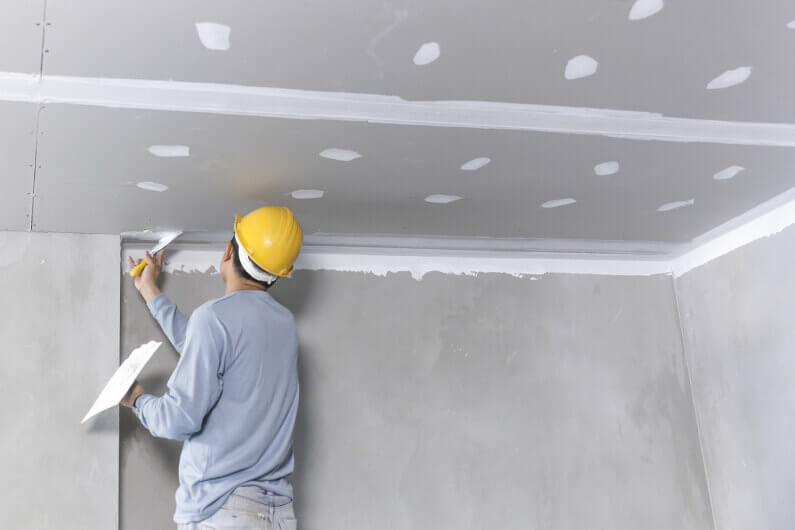Drywall Installment Facilitated: Tips for Perfect Results
Drywall installation is commonly perceived as an overwhelming task, yet with the appropriate method and expertise, it can end up being a convenient endeavor. Grasping strategies for cutting, hanging, and ending up drywall can significantly affect the end result.
Choosing the Right Products
Picking the suitable materials for drywall installment is essential to accomplishing a durable and visually pleasing coating. drywall repair. The key component, drywall sheets, usually can be found in numerous thicknesses, with 1/2-inch sheets being conventional for indoor wall surfaces. For locations requiring additional wetness resistance, such as washrooms or cooking areas, think about using green board or concrete board, which are particularly designed to withstand humidity

Additionally, selecting the right bolts-- either screws or nails-- is crucial for safeguarding the drywall to the framework. Drywall screws are normally favored for their holding power and decreased risk of popping. Last but not least, take into consideration the complements such as primer and paint, which not only enhance the look however also protect the drywall from dampness and wear.
Preparing the Installment Area
Before beginning the drywall installment process, it is necessary to prepare the installation location extensively. A clean work space minimizes the danger of damages to existing products and permits for efficient motion throughout installation.
Next, evaluate the walls and ceiling for any type of blemishes, such as cracks, holes, or mold and mildew. Address these problems in advance; spot any problems and allow sufficient time for repairs to completely dry. Furthermore, make sure that electric outlets, switches, and pipes are effectively positioned and represented, as this will certainly influence drywall positioning.
Think about the environmental conditions also. A steady temperature and humidity level are vital for optimal adhesion and performance of the drywall materials. If required, use a dehumidifier or heater to create suitable problems.
Cutting and Hanging Drywall
The key to reliable drywall installment depends on the exact cutting and hanging of the panels. Begin by measuring the room properly, taking into consideration any type of obstructions such as electric outlets or home windows. Utilize a straight edge and an energy blade to rack up the drywall along your dimensions, then snap it along the racked up line for a clean break. For more detailed cuts, such as around electrical outlets, a drywall saw can be used for precision.

Always function from the top down and entrusted to right, guaranteeing that you keep a staggered pattern to enhance stability. Effectively hanging the drywall sets the structure for a smooth that site finish, ultimately causing premium lead to your drywall project.
Insulation and Mudding Techniques
While appropriate cutting and dangling of drywall establishes their explanation the stage, the next critical step includes grasping taping and mudding strategies to ensure a seamless surface. Insulation is essential for strengthening joints and protecting against cracks; it involves embedding tape into the used joint substance (mud) Beginning with a top quality fiberglass or paper tape, applying the tape over the joint and pressing it into the wet mud utilizing a taping knife, making sure no air bubbles continue to be.
As soon as the tape remains in location, use a slim layer of joint substance over the tape, feathering the sides to develop a smooth change to the drywall surface area. Allow this layer to dry completely before sanding it lightly to remove imperfections. Repeat this process, using additional layers of mud as necessary-- generally two to three coats-- while gradually widening the application area with each layer to attain a smooth appearance.
After the last layer dries, sand the surface with a fine-grit sandpaper until smooth. drywall repair. Keep in mind to use a mask during sanding to avoid breathing in dust fragments. Understanding these taping and mudding strategies is important for accomplishing a professional-quality surface in your drywall installation
Finishing Touches for Excellence
Attaining a perfect drywall setup goes beyond mudding and taping; it finishes in the completing touches that elevate the total look. These final actions are critical in making sure a professional-grade surface that improves the aesthetics of your space.
Begin by fining sand the dried out joint compound to develop a smooth surface. Use a fine-grit sandpaper and a fining sand block or pole sander for optimum control. Pay specific attention to edges and edges, as these locations have a tendency to require even more precise job. After sanding, clean down the walls with a wet fabric to get rid of any type of dust bits, ensuring a tidy surface for paint.
Following, apply a primer especially created for drywall. This action is vital, as it aids seal the joint substance and gives an uniform base for the overcoat. As soon as the primer dries, evaluate for any flaws, and repair as needed.
Final Thought
In verdict, effective drywall installment pivots on the mindful option of products, detailed prep work of the installment location, and specific implementation of reducing and hanging strategies. Proficiency website here of taping and mudding procedures is necessary for accomplishing a smooth surface.
Drywall setup is commonly viewed as a complicated job, yet with the ideal method and understanding, it can become a manageable undertaking.Picking the ideal products for drywall setup is essential to achieving a durable and cosmetically pleasing coating.Before beginning the drywall installation procedure, it is necessary to prepare the setup area extensively. Understanding these taping and mudding techniques is crucial for attaining a professional-quality coating in your drywall setup.
In conclusion, effective drywall setup hinges on the mindful choice of products, complete preparation of the installation location, and precise implementation of cutting and hanging techniques.